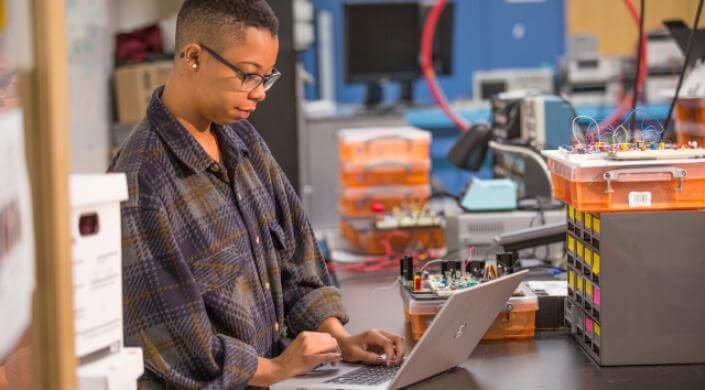News
Applied math concentrator Diondra Peck, A.B. '17, builds computer vision models for use in radiology that have better object recognition. (Photo by Eliza Grinnell/SEAS Communications.)
This applied math concentrator has set her sights on using computer vision techniques to improve medical diagnoses.
Why did you decide to concentrate in applied math at SEAS?
Actually, I didn’t like math in high school. During my senior year, I had a really great Calculus teacher who helped me realize that I want to pursue math. I was already interested in biology, so I came to Harvard thinking about ways to infuse math into that area. As an applied math concentrator with a focus in biomedical engineering, I get to develop a lot of cool math and computer science skills, and then choose which parts of the body I want to apply those skills to. It has been a really good fit.
How do math and biomedical engineering combine in your research at Boston Children’s Hospital?
I work in the lab of Gabriel Kreiman, Assistant Professor of Ophthalmology at Harvard Medical School, who studies biological and computational mechanisms of computer vision. My role is to build computer vision models that have better object recognition. An assistive algorithm running in the background during a procedure could tell a radiologist what they are seeing is probably a tumor, as opposed to a cyst or something else entirely. There are many complicated problems in radiology that could be helped by having better computer vision models.
How has that work informed your senior thesis project?
For my thesis, I built contextually aware computer vision models, which are very similar to the work I’ve done at Children’s. Computer vision models are good at basic object recognition—the computer recognizes an apple in the grocery store because it has seen apples before. But a human also understands context, so he or she would know it is an apple because it is sitting next to oranges in the fruit aisle. My hope is that we can find a way to quantify that context mathematically and incorporate it into an algorithm that can help computer vision models work like a human brain.
Research is clearly one of your passions. How have you promoted research as president of the Harvard Society of Black Scientists and Engineers?
The mission of the Harvard Society of Black Scientists and Engineers is to increase the representation of black students in the sciences and math and engineering. The society has mentorship programs and conducts outreach to the community, largely through “science days” in the spring where Harvard students visit local schools. The power of representation is really strong. Just seeing one person doing what you’d like to do, like a black woman who is pursuing a biomedical engineering career, might inspire a younger student. Representation is sometimes overlooked, but it can be a very powerful motivator. If students don’t see others in the field like them, they might think, even subconsciously, that they are not welcome there.
In her spare time, Peck enjoys cycling around the Cambridge area. (Photo by Eliza Grinnell/SEAS Communications.)
You also mentored students through the Science Club for Girls. Why has that been a rewarding activity?
Every week, a group of women studying STEM or working in STEM fields visited a local elementary or middle school to teach a class for girls on topics ranging from chemistry to paleontology to civil engineering. It was great for these girls to see older women who are following a path they aspire to. For me, it was fun to revisit science lessons in an interactive way. Exploring the world through a child’s lens makes science fun for both the students and teachers.
You’ve also applied your research skills in areas outside the scientific realm. Tell us about one of those experiences.
Through the Institute of Politics at the Harvard Kennedy School, I completed an internship at the Massachusetts State House during my sophomore year. I was in the technology policy group, working with a senator who wanted to know more about the health effects of computed tomography scans, and the radiation they emit. She wanted to see if they posed any kind of public health risk and, if so, what kinds of guidelines or best practices are being used in other parts of the country. That was a great way to use engineering principles and scientific knowledge to solve a problem in government.
Thinking about all these different research, teaching, and mentorship activities, what are your plans for the future?
I am planning to pursue an M.D./Ph.D. with the goal of becoming a medical researcher. My aspiration is to work on computer vision models for medical diagnosis. I want to be able to develop computer algorithms and software that will enhance our ability to diagnose patients non-invasively.
Meet Diondra
Name: Diondra Peck
Class: 2017
Hometown: New Orleans
Concentration: Applied math
Hobbies: Cycling, playing piano and guitar, reading, watching “Jeopardy”
Fun Fact: Peck records “Jeopardy” each day so she never misses an episode. She plans to try out to be a contestant on the show.
Diondra Peck, A.B. '17
Applied math concentrator Diondra Peck talks about her interest in biomedical imaging and her efforts to build computer vision models that allow for better object recognition.
Cutting-edge science delivered direct to your inbox.
Join the Harvard SEAS mailing list.
Press Contact
Adam Zewe | 617-496-5878 | azewe@seas.harvard.edu
